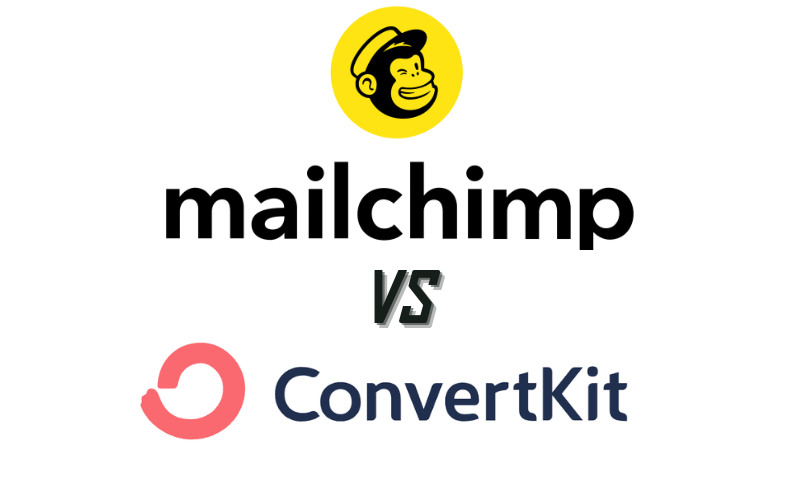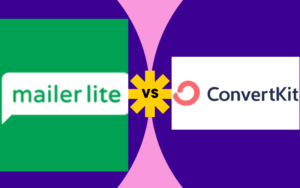Embarking on a successful email marketing journey requires the right tools, and choosing the ideal platform is a crucial first step. In this comprehensive comparison, we delve into the strengths, weaknesses, and real-world experiences of two prominent players in the field: Mailchimp and ConvertKit. Whether you’re a seasoned marketer or a budding entrepreneur, understanding the intricacies of each platform will empower you to make an informed decision tailored to your unique needs. Let’s unravel the nuances of Mailchimp and ConvertKit to guide you toward elevating your email marketing strategy.
Table of Contents
Pricing and Plans of Mailchimp vs Convertkit
When comparing Mailchimp vs ConvertKit, understanding the pricing structures is crucial for making an informed decision tailored to your needs. Let’s delve into the pricing and plans offered by both platforms.
Mailchimp Pricing
Mailchimp provides a tiered pricing model, including a free plan for beginners. As your email list grows, you can choose from the Essentials, Standard, or Premium plans. The Essentials plan caters to small businesses, offering features like email campaigns and basic automation. The Standard and Premium plans provide advanced features such as multivariate testing and advanced segmentation.
It’s important to note that Mailchimp’s pricing is based on the number of subscribers in your list. As your audience grows, you’ll naturally move up the pricing tiers.

ConvertKit Pricing
ConvertKit takes a different approach with its pricing, focusing on the features rather than the number of subscribers. The plans are divided into Free, Creator, and Creator Pro. The Free plan is suitable for those starting, while the Creator and Creator Pro plans offer advanced features like automated funnels and premium support.
ConvertKit’s pricing model is advantageous for businesses with a rapidly growing subscriber base. You won’t face sudden cost spikes as your list expands.

User Interface of Mailchimp vs Convertkit
The user interface plays a pivotal role in the overall user experience when comparing Mailchimp and ConvertKit. Let’s explore how each platform’s interface caters to users.
Mailchimp User Interface
Mailchimp boasts an intuitive and user-friendly interface designed to accommodate users of all levels. Navigating through the dashboard is straightforward, making it easy to create and manage email campaigns. The drag-and-drop editor simplifies the process of designing visually appealing emails, even for those without extensive design skills.
The dashboard provides a comprehensive overview of your campaigns, audience engagement, and analytics. Mailchimp’s clean design and organized layout contribute to a seamless user experience.
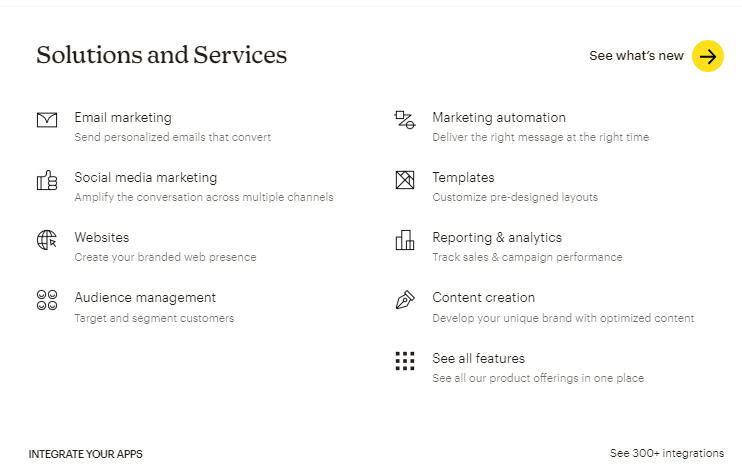
ConvertKit User Interface
ConvertKit takes a minimalist approach to its user interface, prioritizing simplicity and functionality. The dashboard is uncluttered, focusing on the essentials for effective email marketing. The straightforward menu options guide users through creating automation sequences and managing subscriber lists.
ConvertKit’s interface is particularly favored by content creators and bloggers for its ease of use. The platform prioritizes clarity and efficiency, ensuring users can navigate without unnecessary distractions.

Email Campaign Creation of Mailchimp vs Convertkit
Creating engaging and effective email campaigns is a fundamental aspect of any email marketing platform. Let’s compare how Mailchimp and ConvertKit facilitate the process of crafting compelling email campaigns.
Mailchimp Email Campaign Creation
Mailchimp offers a robust set of tools for crafting visually appealing email campaigns. The platform’s drag-and-drop editor allows users to easily design emails without the need for extensive coding skills. With a variety of templates and customization options, Mailchimp caters to both beginners and experienced marketers.
Additionally, Mailchimp provides features like A/B testing, allowing you to experiment with different elements of your campaigns to optimize performance. The platform’s content studio enables efficient management of images and files, streamlining the campaign creation process.
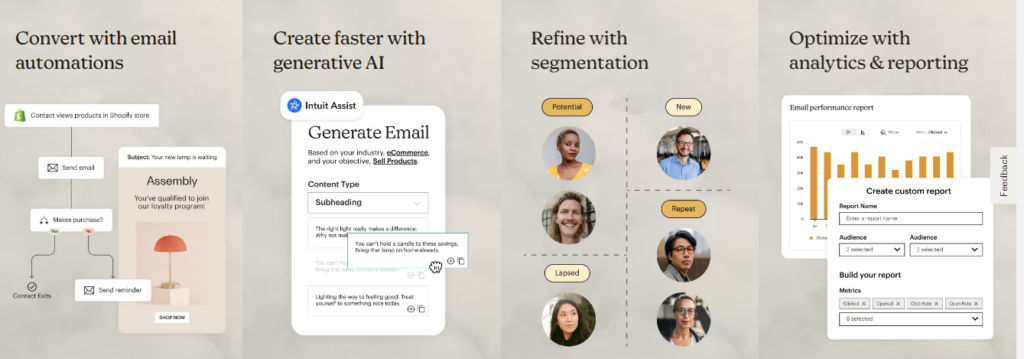
ConvertKit Email Campaign Creation
ConvertKit focuses on simplicity in email campaign creation. The platform’s visual automation builder helps users create automated sequences effortlessly. ConvertKit’s emphasis on “sequences” makes it easy to set up a series of emails that automatically go out based on subscriber actions.
While ConvertKit may not offer as many templates as Mailchimp, it excels in creating targeted and personalized campaigns. The platform’s focus on content creators and bloggers is evident in its straightforward approach to campaign creation.

Automation of Mailchimp vs Convertkit
Automation is a key feature in email marketing platforms, streamlining processes and saving time for marketers. Let’s explore how Mailchimp and ConvertKit handle automation to help you make an informed decision.
Mailchimp Automation
Mailchimp offers a robust automation feature set, allowing users to create intricate workflows to engage subscribers based on their actions. The platform’s visual journey builder simplifies the process of setting up automation sequences. From welcoming new subscribers to nurturing leads and re-engaging dormant contacts, Mailchimp’s automation capabilities cover a wide range of scenarios.
Additionally, Mailchimp provides pre-built automation templates for common scenarios, making it easy for users to get started with automation even if they are new to the concept.

ConvertKit Automation
ConvertKit excels in providing a straightforward and visual automation builder, making it easy for users to create automated sequences. The platform’s “visual automation” allow content creators to design intricate workflows based on subscriber behavior.
ConvertKit’s automation is centered around “tags” and “triggers,” enabling users to precisely target and personalize their communication. This approach is particularly beneficial for those who prioritize personalized content in their automation strategies.
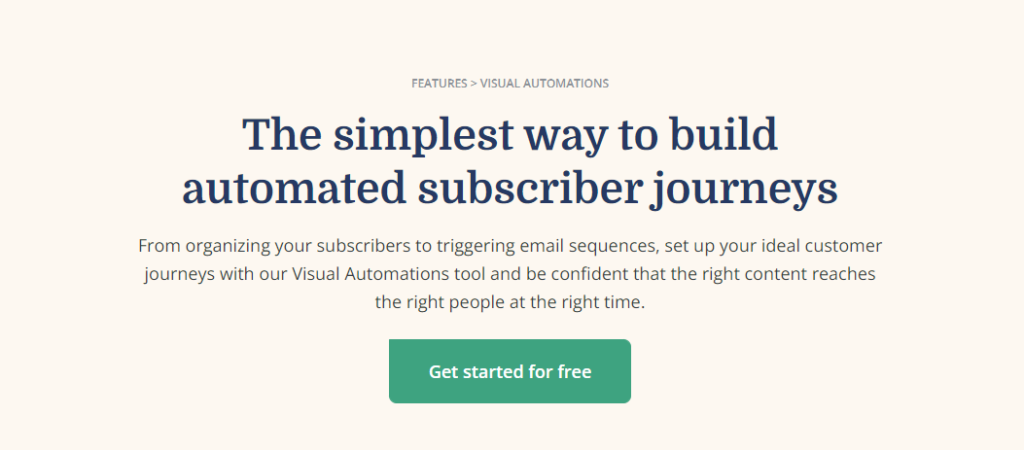
Integration with Third-Party Tools of Mailchimp vs Convertkit
Seamless integration with third-party tools is crucial for maximizing the efficiency of your email marketing efforts. Let’s explore how Mailchimp and ConvertKit handle integration with external applications and services.
Mailchimp Integration
Mailchimp offers an extensive array of integrations with third-party tools and platforms. From e-commerce solutions like Shopify and WooCommerce to CRM systems like Salesforce, Mailchimp provides pre-built integrations that make it easy to connect and sync data across different applications.
Additionally, Mailchimp’s open API allows for custom integrations, providing flexibility for businesses with unique integration needs. This extensive compatibility enhances Mailchimp’s versatility in catering to various business setups.
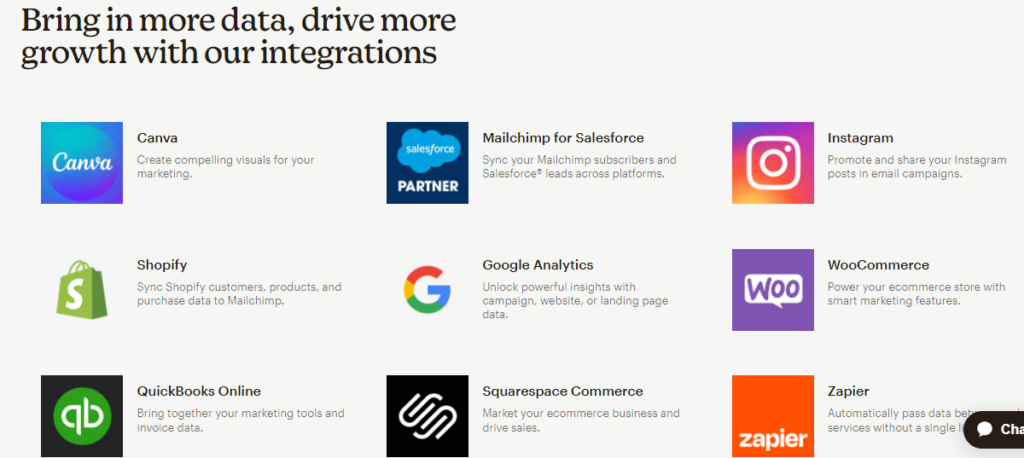
ConvertKit Integration
ConvertKit, while not as extensive as Mailchimp in terms of the sheer quantity of integrations, focuses on quality and relevance. The platform provides integrations with popular tools such as WordPress, Shopify, and Zapier, allowing users to connect their email marketing efforts seamlessly with other essential applications.
ConvertKit’s integrations are designed to complement the needs of content creators and bloggers, ensuring that the tools they rely on can easily work in tandem with their email marketing platform.
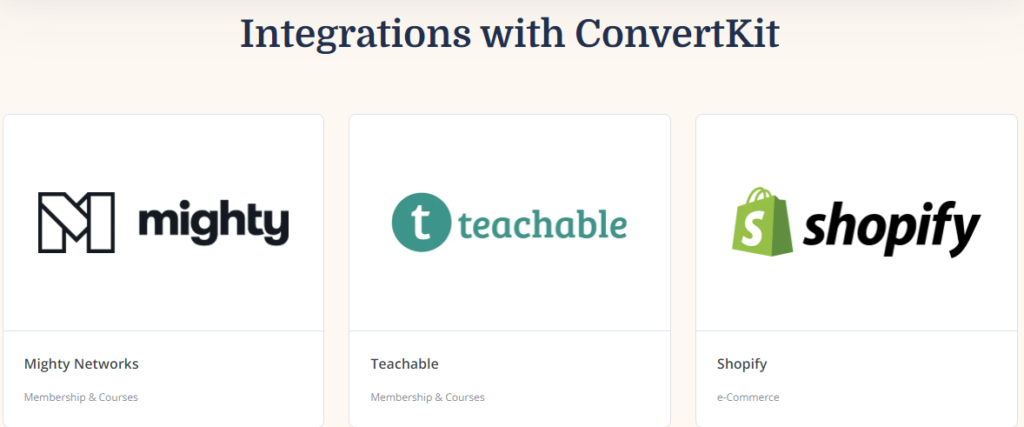
Analytics and Reporting of Mailchimp vs Convertkit
Analyzing the performance of your email campaigns is essential for refining your strategies and maximizing engagement. Let’s compare how Mailchimp and ConvertKit handle analytics and reporting to provide you with valuable insights.
Mailchimp Analytics and Reporting
Mailchimp offers a comprehensive analytics dashboard that gives users a detailed overview of their campaign performance. From open rates and click-through rates to subscriber growth, Mailchimp’s analytics provide key metrics in an easily digestible format. The platform also allows users to track e-commerce activity and revenue generated from email campaigns.
Mailchimp’s reporting tools extend beyond basic metrics, offering insights into audience behavior, and allowing marketers to make informed decisions to enhance their future campaigns.
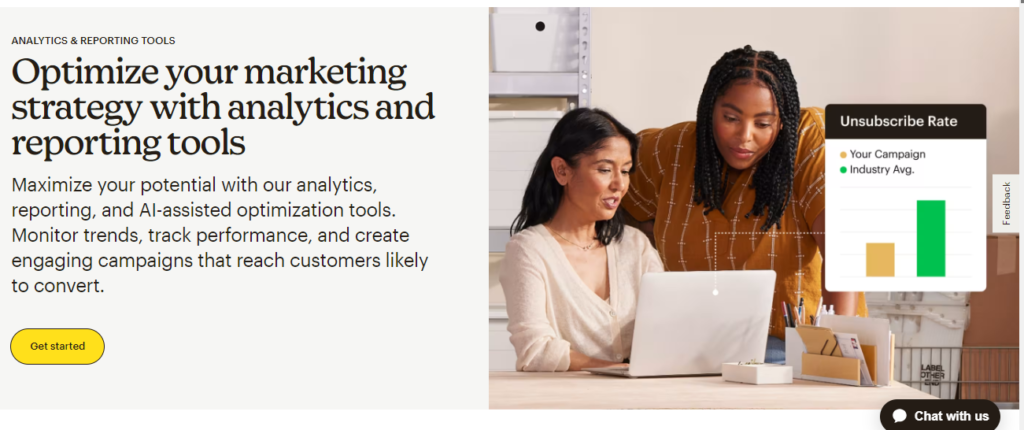
ConvertKit Analytics and Reporting
ConvertKit’s analytics focus on simplicity and clarity. The platform provides essential metrics, including open rates, click rates, and subscriber growth. ConvertKit’s reporting is designed to be straightforward, ensuring users can quickly assess the performance of their campaigns.
Additionally, ConvertKit’s visual automation report helps users understand how subscribers move through their automated sequences, aiding in refining and optimizing workflows.

Customer Support of Mailchimp vs Convertkit
Effective customer support is crucial when navigating the complexities of an email marketing platform. Let’s explore how Mailchimp and ConvertKit handle customer support to ensure you receive the assistance you need.
Mailchimp Customer Support
Mailchimp provides a range of customer support options to assist its users. The platform offers email support for users on the Free and Essentials plans, while Standard and Premium plan users have access to 24/7 email and chat support. Mailchimp’s knowledge base is extensive, covering a wide range of topics with detailed articles and tutorials.
Additionally, Mailchimp offers a community forum where users can connect with fellow marketers, share experiences, and seek advice. The platform’s commitment to providing various support channels caters to users with different preferences.
ConvertKit Customer Support
ConvertKit places a strong emphasis on personalized and timely customer support. The platform provides email support to all users, and Creator Pro plan subscribers enjoy priority support. ConvertKit’s support team is known for its responsiveness and dedication to helping users resolve issues promptly.
ConvertKit also offers a comprehensive knowledge base, ensuring users can find answers to common questions and troubleshoot issues independently.
Advantages of Mailchimp
Mailchimp, a widely used email marketing platform, offers several advantages that contribute to its popularity among marketers. Let’s explore the key strengths that set Mailchimp apart.
1. User-Friendly Interface
Mailchimp boasts an intuitive and user-friendly interface, making it accessible to both beginners and experienced marketers. The platform’s drag-and-drop editor simplifies the process of creating visually appealing email campaigns without the need for advanced design skills.
2. Comprehensive Automation Tools
Mailchimp provides robust automation features, allowing users to create intricate workflows that engage subscribers based on their actions. From onboarding sequences to targeted re-engagement campaigns, Mailchimp’s automation tools cover a wide range of scenarios.
3. Extensive Integrations
With a vast library of integrations, Mailchimp seamlessly connects with various third-party tools and platforms. Whether you’re using e-commerce solutions, CRM systems, or analytics tools, Mailchimp ensures compatibility to enhance your overall marketing strategy.
4. Advanced Analytics and Reporting
Mailchimp’s analytics dashboard offers a detailed overview of campaign performance. From open rates and click-through rates to revenue generated from e-commerce activities, Mailchimp provides comprehensive insights to refine and optimize your email marketing strategies.
5. Diverse Template Options
Mailchimp offers a diverse range of email templates suitable for different industries and purposes. Whether you’re sending newsletters, promotional emails, or event invitations, Mailchimp’s templates provide a solid foundation for creating visually appealing and effective campaigns.
Advantages of ConvertKit
ConvertKit, a specialized email marketing platform, offers distinct advantages that cater to the needs of content creators and bloggers. Let’s delve into the key strengths that make ConvertKit a preferred choice for certain users.
1. Content-Centric Automation
ConvertKit excels in content-centric automation, allowing users to create seamless and personalized email sequences. The platform’s visual automation builder makes it easy for content creators to design intricate workflows based on subscriber behavior.
2. Simplicity in Design
The platform adopts a minimalist and user-friendly design, prioritizing simplicity and efficiency. ConvertKit’s uncluttered interface focuses on the essentials, making it easy for users to navigate and create campaigns without unnecessary distractions.
3. Tagging and Segmentation
ConvertKit’s approach to tagging and segmentation simplifies audience management. Users can apply tags based on subscriber behavior, enabling precise targeting for personalized communication. This feature is particularly valuable for content creators looking to tailor their messaging.
4. Creator Community and Support
ConvertKit fosters a strong sense of community among content creators. The platform provides email support to all users, with Creator Pro plan subscribers enjoying priority support. The responsive and dedicated support team contributes to a positive user experience.
5. Integration with Essential Tools
While offering fewer integrations compared to some platforms, ConvertKit focuses on key partnerships relevant to content creators. Seamless integration with tools like WordPress, Shopify, and Zapier ensures that users can connect their email marketing efforts with other essential applications.
Limitations of Mailchimp
While Mailchimp is a popular and versatile email marketing platform, it’s essential to be aware of its limitations. Let’s explore some of the constraints users may encounter when using Mailchimp for their marketing campaigns.
1. Cost Scaling with Subscribers
One notable limitation of Mailchimp is its pricing model, which scales with the number of subscribers in your list. As your audience grows, so does the cost of using Mailchimp. This can be a drawback for businesses experiencing rapid subscriber growth, leading to potentially higher expenses.
2. Complexity for Beginners
Despite its user-friendly interface, Mailchimp’s extensive feature set can be overwhelming for beginners. Users who are new to email marketing may find the platform’s range of options and settings daunting, requiring a learning curve to fully harness its capabilities.
3. Template Customization Constraints
While Mailchimp offers a diverse range of email templates, customization options can be somewhat limited. Users looking for highly personalized or unconventional designs may find the template customization constraints restrictive compared to other platforms.
4. Automation Functionality in Free Plan
The free plan of Mailchimp has limitations when it comes to automation functionality. Users on the free plan may find that advanced automation features are only available in higher-tier plans. This restriction can impact the ability to implement sophisticated automated workflows.
Limitations of ConvertKit
While ConvertKit offers a streamlined approach to email marketing, it’s essential to be aware of its limitations. Let’s explore some of the constraints users may encounter when using ConvertKit for their marketing campaigns.
1. Limited Template Variety
One notable limitation of ConvertKit is its relatively limited template variety compared to some other platforms. Users seeking a wide array of pre-designed templates for different purposes may find ConvertKit’s options more constrained.
2. Advanced Automation Complexity
While ConvertKit excels in simplicity, users with complex automation needs may find certain limitations. Creating intricate and highly detailed automation sequences may require more manual steps compared to platforms with more robust automation capabilities.
3. Focused on Content Creators
ConvertKit’s specialization in catering to content creators may be a limitation for businesses with diverse marketing needs. Users outside the content creation and blogging sphere may find some features and templates less applicable to their specific industry or use case.
4. Less Extensive Integrations
ConvertKit, while providing essential integrations, has a more focused selection compared to some other platforms. Users with a reliance on specific third-party tools not covered in ConvertKit’s integrations may find the platform less accommodating to their workflow.
User Testimonials of Mailchimp vs Convertkit
User testimonials provide valuable insights into the real-world experiences of individuals using email marketing platforms. Let’s explore what users have to say about their experiences with both Mailchimp and ConvertKit.
Mailchimp User Testimonials
1. Sarah, E-commerce Entrepreneur
“I’ve been using Mailchimp for over two years now, and it has been a game-changer for my e-commerce business. The analytics are detailed, and the automation tools have saved me countless hours. The support team is responsive, helping me navigate any challenges.”
2. Mark, Small Business Owner
“Mailchimp’s user-friendly interface was a huge draw for me. Even as a small business owner with limited technical skills, I found it easy to create and manage campaigns. The variety of templates allowed me to experiment with different styles.”
3. Jessica, Marketing Professional
“As a marketing professional, Mailchimp’s extensive integrations have been a lifesaver. Connecting it with our CRM and e-commerce platform was seamless. The A/B testing feature also helped us optimize our campaigns for better engagement.”
ConvertKit User Testimonials
1. Ryan, Blogger
“ConvertKit’s simplicity is what sets it apart for me. The visual automation builder made it easy to set up complex sequences without getting overwhelmed. The support team has been fantastic, providing quick and helpful responses.”
2. Emily, Content Creator
“As a content creator, ConvertKit’s focus on tags and segmentation aligns perfectly with my needs. It allows me to tailor my messages based on subscriber behavior. The community support has been invaluable for sharing tips and strategies.”
3. Alex, Online Educator
“ConvertKit’s integration with my online teaching tools was a deciding factor. The platform seamlessly works with my course platforms, making it easy to nurture leads and communicate with my students. The straightforward analytics also help me track performance.”
Conclusion
In the realm of email marketing, choosing the right platform is a pivotal decision that can significantly impact the success of your campaigns. Both Mailchimp and ConvertKit offer distinct advantages, catering to diverse needs within the digital marketing landscape.
Mailchimp stands out with its user-friendly interface, comprehensive automation tools, extensive integrations, advanced analytics, and a wide variety of email templates. It’s a versatile choice for businesses of all sizes, providing a robust foundation for crafting and managing effective email campaigns.
On the other hand, ConvertKit excels in simplicity, content-centric automation, effective tagging and segmentation, a strong community for support, and integration with essential tools. It’s particularly well-suited for content creators, bloggers, and those who prioritize personalized communication.
Understanding the limitations of each platform is crucial. Mailchimp’s potential drawbacks include cost scaling with subscribers, complexity for beginners, and template customization constraints. ConvertKit’s limitations include a more focused template variety, complexity in advanced automation, and a narrower selection of integrations.
Ultimately, the choice between Mailchimp and ConvertKit depends on your specific needs, preferences, and the nature of your business. Consider factors such as your budget, the complexity of your marketing strategies, and the level of personalization you aim to achieve.
To make an informed decision, reflect on the insights shared in this comparison, taking into account the user testimonials that offer real-world perspectives. Whether you prioritize the versatility of Mailchimp or the simplicity of ConvertKit, both platforms empower you to create meaningful connections with your audience through effective email marketing.
Make your decision based on what aligns best with your goals, and may your email campaigns thrive in the ever-evolving digital landscape.
Ready to Choose Your Platform?
If you’re leaning towards the versatility of Mailchimp, explore their plans, features, and get started on crafting engaging email campaigns. Click here to visit the Mailchimp website and begin your email marketing journey.
On the other hand, if the simplicity and content-centric approach of ConvertKit resonate with your goals, dive into their offerings and start building personalized connections. Click here to explore ConvertKit’s features and kickstart your email marketing experience.
Still Undecided? Need More Insights?
If you find yourself on the fence or have additional questions, why not delve deeper into user experiences? Explore more user testimonials, reviews, and discussions to gain further perspectives.

